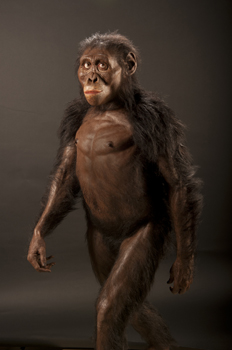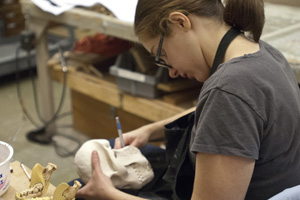Go back in time to meet a brand-new Lucy
The Museum opened a newly renovated permanent exhibit, the Human Origins Gallery, featuring two new reconstructions of Lucy, the famous 3.2 million-year-old partial fossil skeleton of the species Australopithecus afarensis. Lucy was discovered in Ethiopia in 1974 by Dr. Donald Johanson, a former curator at the Museum.
 Developed under the direction of Dr. Yohannes Haile-Selassie, the Museum's curator of physical anthropology, the gallery explores the evolution of various early human ancestor species and outlines the physical changes through time leading to modern humans. The exhibition is organized into seven thematic stages based on milestones. It also features a special section that celebrates current research of the Museum's curators.
Developed under the direction of Dr. Yohannes Haile-Selassie, the Museum's curator of physical anthropology, the gallery explores the evolution of various early human ancestor species and outlines the physical changes through time leading to modern humans. The exhibition is organized into seven thematic stages based on milestones. It also features a special section that celebrates current research of the Museum's curators.
"This new gallery will be one of the most up-to-date human evolution galleries in the world," said Haile-Selassie. "It includes casts of early human ancestor fossils that are currently under active research. Starting with our place in nature as primates, the gallery traces the entire journey we have traveled for almost 6 million years to become who we are today—a large-brained animal living in a digital age."
Lucy will greet visitors, serving as the focal point of the gallery with two brand-new versions of her reconstruction—lifelike and skeletal—on display. Posed in a striding position, they will be arranged back to back. Museum artisans sculpted skeletal elements, cast 102 pieces in resin and painstakingly assembled the mount of the famous partial skeleton. The articulated mount reflects current knowledge of the individual's anatomy based on new fossil evidence. It features a newly sculpted and reshaped rib cage handcrafted from foam and a spine that more accurately represents the curvature of the lower back.
 Sharing the spotlight with the new Lucy skeletal mount will be a strikingly lifelike sculpture created by internationally renowned paleoartist John Gurche. This fully "fleshed-out" model details the muscular build and facial features of the upright walking Lucy. The award-winning artist sculpted the work in clay from the Museum's skeleton cast, then molded and cast the piece in silicone. It was then painted and implanted with natural-looking eyes and hair.
Sharing the spotlight with the new Lucy skeletal mount will be a strikingly lifelike sculpture created by internationally renowned paleoartist John Gurche. This fully "fleshed-out" model details the muscular build and facial features of the upright walking Lucy. The award-winning artist sculpted the work in clay from the Museum's skeleton cast, then molded and cast the piece in silicone. It was then painted and implanted with natural-looking eyes and hair.
Overall, the Human Origins Gallery features more than 40 specimens, including fossil casts. Among the key specimens is a cast of "Kadanuumuu," a specimen of Lucy's species recently discovered by an international team led by Haile-Selassie that is still under active research. In addition to specimen displays, visitors can engage in hands-on and media-based interactive exhibits.
The gallery was designed and built by the Museum's exhibits team. Dr. Denise Su, curator of paleobotany and paleoecology, collaborated on the project. The modern gallery is designed for visitors of all ages to better understand human origins and to have fun while learning.
The Museum's former human evolution gallery was created nearly three decades ago. Because there have been many exciting new discoveries and advances in the field of human evolutionary studies in the last 30 years, a complete renovation and expansion was undertaken. This new gallery serves as a small preview of the new exhibits that will be developed as part of the Museum's major transformation project, scheduled to begin construction in 2015. In addition, the gallery will allow Museum staff to evaluate visitor response to the new exhibits, further informing the process of updating the Museum.
The Human Origins Gallery is free with Museum admission.
For more information, downloadable hi-res photos and more, visit the Press Room.